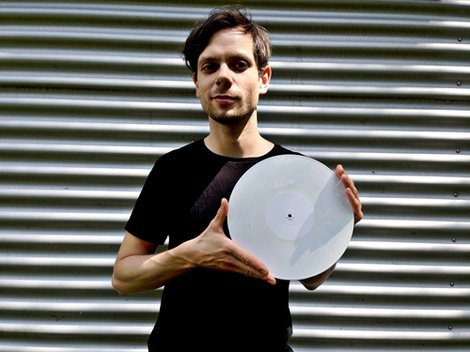Revolution of the vinyl record

When one thinks of records, one equates them with vinyl. For the past 70 years these discs have been made out of vinyl, aka PVC, the basis of which is petroleum, an environmentally-harmful product in terms of both its production and disposal. And architects and designers have been avoiding this material for several decades – mainly because environmentally-friendly, organically-based plastics are available. In this respect, why shouldn’t it be possible for vinyl records to be made from other materials as well?
Trial and error: seeing what works at first hand
At the time, Alexander tried to find the answer to this question in his kitchen by making a shape similar to a baking mould so as to reproduce the grooves of the records. The student pours what he finds in and around the apartment into the mould. He tries it with frozen chocolate, with beeswax, with sugar-water and with concrete. The beeswax record is easy to make, but the soft material scratches after just one use. The chocolate works only briefly as well. Things work out the best with the concrete. "At that time, I was just trying to find out what was generally possible," says the 30-year-old, remembering his initial experiments.
That the student of Play and Learning Design at Burg Giebichenstein starts to look at the vinyl records from a sustainable, creative perspective, has to do with the "Kling und Klang" project at the university, where he and his fellow design students address the topic of music reproduction. In this context, Alexander first looks at the history of sound recording, then immerses himself deeper into the materials behind it and builds a piece of equipment "to understand the principle of production". The 30-year-old is accustomed to combining theory and practice. Before he began studying design, the native of Cottbuss learned the rare trade of organ and harmonium builder in Bad Liebenwerda. As an up-and-coming designer, he is constantly on the lookout for things that can be changed and improved.
The rebirth of the record
With his "Vinyl 2.0" project, he now wants to start off a "small-time revolution". After all, the proof that records can also be made from polylactides, or PLA for short, is just the start. "To be able to use plastics of this kind, machines have to be retrofitted and processes changed," says Alexander. "Vinyl records have been produced for the last 70 years." And at the moment, due to increased demand, production is picking up again and lifting it out of the niche. The record is experiencing a renaissance. Sales of records, which fell to a minimum following the introduction of the CD, have been steadily increasing over the past ten years.
Modifying industrial series production requires courage and will, however, explains Alexander. And the student believes that he has found both of these at a small Hamburg-based records manufacturer by the name of "Ameise". Together with the company’s owner, Martin Sukale, two test runs are underway which have been a success. Alexander has found another partner in the shape of the "R.A.N.D. Muzik" records factory. This Leipzig-based company is supporting his project with technical know-how and equipment. And other things are also happening: the BioEconomy Cluster Halle association has provided scientific advice on materials, and at this year’s state-wide "BESTFORM" competition, from more than 40 submissions, the project made it into the list of nominations. The Stadtmuseum in Halle (Saale) is presenting the project in its permanent exhibition until the end of the year.
The organic record
Alexander – who plays the piano in his spare time – is now seeking further support. His goal is clearly defined: for records made of organic plastics to conquer the market as an alternative to vinyl. To prevent his goal from being a dream and to reduce the reject rate from the initial test series, he wants to try out more plastics and offer more material possibilities. To enable further tests, however, the plastic extruder will have to be retrofitted and the machines given a technical overhaul to allow for the production of new discs – tasks for which the student is currently seeking financial support. "Dedication alone isn’t enough for the project to result in series production," says Alexander. Raising the profile of the organic record helps, however. In Berlin, Alexander is currently holding workshops on how to produce environmentally-friendly discs. The music still plays a secondary role, though. "If the project is a success, I am hoping to find an artist who would then launch their first album on the new record," he says. In his first experiments at the records factory, he had to make do with what was being pressed when he presented his template: French electropop. But for Alexander, it’s what’s in the record that’s really important, and not what’s on it.
author: Manuela Bock
photo: private





